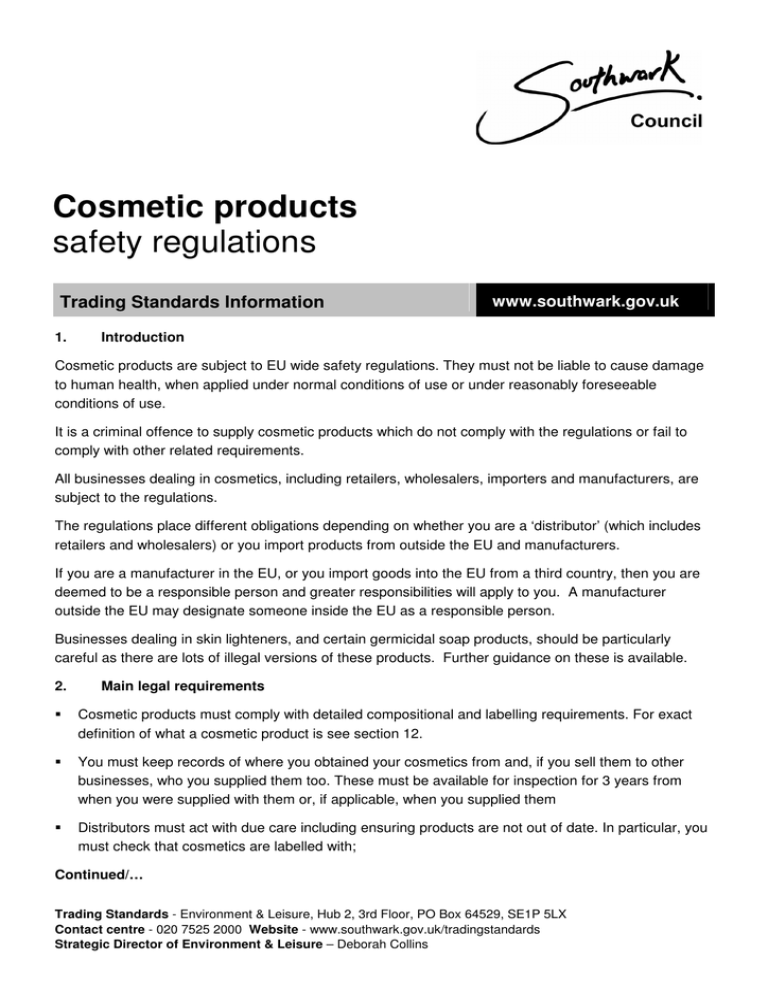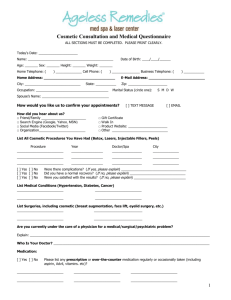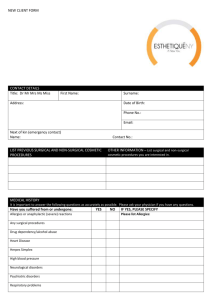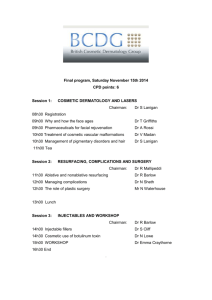Cosmetic products safety regulations
advertisement

Cosmetic products safety regulations Trading Standards Information 1. www.southwark.gov.uk Introduction Cosmetic products are subject to EU wide safety regulations. They must not be liable to cause damage to human health, when applied under normal conditions of use or under reasonably foreseeable conditions of use. It is a criminal offence to supply cosmetic products which do not comply with the regulations or fail to comply with other related requirements. All businesses dealing in cosmetics, including retailers, wholesalers, importers and manufacturers, are subject to the regulations. The regulations place different obligations depending on whether you are a ‘distributor’ (which includes retailers and wholesalers) or you import products from outside the EU and manufacturers. If you are a manufacturer in the EU, or you import goods into the EU from a third country, then you are deemed to be a responsible person and greater responsibilities will apply to you. A manufacturer outside the EU may designate someone inside the EU as a responsible person. Businesses dealing in skin lighteners, and certain germicidal soap products, should be particularly careful as there are lots of illegal versions of these products. Further guidance on these is available. 2. Main legal requirements Cosmetic products must comply with detailed compositional and labelling requirements. For exact definition of what a cosmetic product is see section 12. You must keep records of where you obtained your cosmetics from and, if you sell them to other businesses, who you supplied them too. These must be available for inspection for 3 years from when you were supplied with them or, if applicable, when you supplied them Distributors must act with due care including ensuring products are not out of date. In particular, you must check that cosmetics are labelled with; Continued/… Trading Standards - Environment & Leisure, Hub 2, 3rd Floor, PO Box 64529, SE1P 5LX Contact centre - 020 7525 2000 Website - www.southwark.gov.uk/tradingstandards Strategic Director of Environment & Leisure – Deborah Collins 3. o The name and address of a responsible person in the EU o A batch or manufacture reference number o An ingredients list. This must be headed ‘ingredients’ What are the compositional and labelling requirements? On the container and outer packaging the following information must be clearly and permanently marked in English. It may also be in other languages as well; The function of the product, unless this is clear from its presentation The name or style and address of the manufacturer or person responsible for marketing it who is established in the EU. For example a product manufactured in the USA and displaying only an American address is not sufficient. The address of the importer into the EU must also be given The country of origin if manufactured outside the EEA A batch number of manufacture, or other reference for identifying the goods (this may be on packaging only if the product is too small to accommodate it) Particular precautions, warnings and conditions for safe use including special precautions for professional use products If the life expectancy of the product is less than 30 months the words ‘best used before’ and the relevant date showing the month and year or day month and year must be given. Any conditions required to sustain that life expectancy must also be given. This symbol may be used to indicate date of minimum durability If the life expectancy of the product is more than 30 months then the special symbol shown here must be used to indicate how long after opening the product can be used without harm. The period should be shown in months or years or both On the packaging the following information must be clearly and permanently marked in English. It may also be in other languages as well; A list preceded by the word ‘ingredients’ stating the ingredients in descending order of weight. The ingredients must be identified by their INCI description (this is a special international name) There exceptions where it is not practical or possible for all the information to be shown on the packaging or container because of size. In some cases the information can be given in a leaflet accompanying the product and the symbol shown here can be used to indicate this. 4. Prohibited substances Over 1,300 substances are prohibited from being used in cosmetic products. For example, chlorine, cyanides, iodine, mercury and mercury compounds such as mercuric iodide. Note that skin lightening creams contain hydroquinone are also illegal. Corticosteroids are also prohibited. These may have a skin lightening effect but are also often sold as treatments for disorders such as eczema and psoriasis. Any products with Corticosteroid substances like Clobetasol Propionate, Bethamethasone or Bethamethosone Dipropionate must not be on sale in cosmetic shops. Supply of such products may also be an offence under medicines legislation. Continues/… 5. Restricted substances Over 250 substances can only be used in cosmetics subject to restrictions. These restrictions may only allow a maximum amount of a substance or require additional warning or precautionary markings. For example hair dyes and straighteners intended for professional use may contain hydrogen peroxide. The maximum permitted limit is 12% and the following precautions and instructions should be present ‘Wear suitable gloves. Contains hydrogen peroxide. Avoid contact with eyes. Rinse eyes immediately if product comes into contact with them’. 6. Permitted substances Only certain substances may be used in cosmetic products as colourants, preservatives and UV filters. These are all specified in the regulations. 7. What other requirements are there for responsible persons? In order to demonstrate that a cosmetic product is safe the responsible person must ensure that the cosmetic product has undergone a safety assessment and that a cosmetic product safety report is produced. This safety assessment shall be carried out by a person in possession of suitable formal qualifications. It must be kept for 10 years from when the last batch was placed on the market. Where a cosmetic product is supplied or manufactured in the UK, the responsible person is required to keep certain product information at the registered office address or the address detailed on the product. This information must be easily accessible to enforcement authorities and can be requested in the case of medical emergency. The information must be in English and include all of the following: the qualitative and quantitative composition of the product - for perfume or perfume compositions in the product, you are only required to keep the name, code number and supplier identity. Qualitative information for all composites, and the quantitative information in relation to dangerous substances, must also be made easily available to the general public the physico-chemical and microbiological specifications of the raw materials and the finished product, and the purity and microbiological control criteria of the cosmetic product the method of manufacture, which shall be in accordance with good manufacturing practice an assessment of safety for human health of the finished product, including the criteria as stipulated in the Regulation - there are additional criteria where the product is intended for use on children under three years old or exclusively for use in external intimate hygiene the name and address of the person or persons who carried out the assessments existing data on the undesirable effects on human health resulting from use of the product - this information must also be made easily available to the general public evidence to justify any claims made by the product data on any animal testing performed by the manufacturer, his agents or suppliers, relating to the development or safety evaluation of the product or its ingredients Continues/… 8. Notification requirements Prior to placing cosmetic products on the market the responsible person shall submit the following information to the European Commission through the Cosmetic Products Notification Portal (CPNP) the category of cosmetic product and its name or names, enabling its specific identification the name and address of the responsible person where the product information file is made readily accessible in the country of origin in the case of import into the member state in which the cosmetic product is to be placed on the market, the contact details of a physical person to contact in the case of necessity the presence of substances in the form of nanomaterials and their identification the frame formulation allowing for prompt and appropriate medical treatment in the event of difficulties When the cosmetic product is placed on the market, the responsible person shall notify the Commission of the original labelling, and, where reasonably legible, a photograph of the corresponding packaging. 9. Withdrawals and recalls etc. Responsible persons and distributors who consider or have reason to believe that a cosmetic product that they have placed on the market is not in conformity with the Regulations must immediately take the corrective measures necessary to bring that product into conformity, withdraw it or recall it, as appropriate. Where the cosmetic product presents a risk to human health, responsible persons must immediately inform their trading standards service giving details, in particular, of the non-compliance and of the corrective measures taken. 10. What steps can I take to make sure the cosmetic products I sell comply? The steps that businesses should take are dependent upon a number of things, such as, the size of the business and whether it is a manufacturer, importer, wholesaler or a retailer. For example, a small retailer who buys from a local wholesaler will need to carry out physical checks on the stock such as checking the labelling. However if a retailer imports goods themselves they will be deemed a responsible person and will be responsible for compliance with all the requirements. Problems usually arise where shops purchase their stock from people selling door to door or direct from non EU countries. It is recommended that you should only deal with reputable and established EU suppliers. In addition you should always obtain and keep detailed receipts for any stock purchased. 11. What happens if my cosmetic products don’t comply with the Regulations? These EU requirements are implemented in the UK by the Cosmetic Products Enforcement Regulations 2013. Failure to comply could result in goods being seized and prosecution. On conviction in the Crown Courts a fine of up to £20,000 and/or up to 12 months imprisonment may be imposed. If product labelling, marketing or advertising contains misleading information about the efficacy or other characteristics, or omits information so as to be misleading, then any supplier could be guilty of an offence under the Consumer Protection from Unfair Trading Regulations 2008. Continues…. 12. Definition and examples of cosmetic products Cosmetic product means any substance or mixture intended to be placed in contact with the external parts of the human body (skin, hair system, nails, lips and external genital organs) or with the teeth and the mucous membranes of the mouth) with a view exclusively or mainly to cleaning them, perfuming them, changing their appearance, protecting them, keeping them in good condition or correcting body odours. If the above uses are only for the purposes of treating, or preventing diseases etc. then the products may be classed as a medicine and medicines control legislation may apply. This means they require a marketing authorisation or product licence. Restrictions on how and where they may be sold may also apply. For example being sold on prescription only at registered pharmacists. Examples of cosmetic products creams, emulsions, lotions, gels and oils for the skin face masks tinted bases (liquids, pastes, powders) make-up powders after-bath powders hygienic powders toilet soaps deodorant soaps perfumes toilet waters and eau de Cologne bath and shower preparations (salts, foams, oils, gels) Depilatories deodorants and antiperspirants hair colorants products for waving, straightening and fixing hair hair-setting products hair-cleansing products (lotions, powders, shampoos) hair-conditioning products (lotions, creams, oils) hairdressing products (lotions, lacquers, brilliantines) shaving products (creams, foams, lotions) make-up and products removing make-up products intended for application to the lips products for care of the teeth and the mouth products for nail care and make-up products for external intimate hygiene sunbathing products products for tanning without sun skin-whitening products and anti-wrinkle products. 13. Further information If you require further assistance on the regulations, or would like additional information leaflets, please contact us at the address given. Online guidance can be found at; www.gov.uk/product-safety-for-manufacturers www.businesscompanion.info PLEASE NOTE only the Courts can interpret legislation with authority and this leaflet is subject to revision or amendment without notice. (Ref:Cos/1.4 July 2015)





